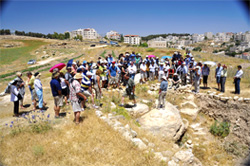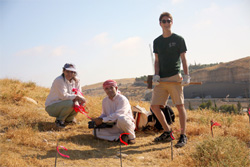Weekly Reports from Jordan
Choose Year: or Choose week
Tall al-`Umayri
25 June 2013
• Paid a nice visit to Raouf Abujaber, long-time friend of our project and partial land owner of `Umayri. While neither of us is optimistic about solving the land-ownership issues anytime soon, given Jordan’s financial woes, we did talk on the phone to Aqel Biltaji, former Minister of Tourism and enthusiastic supporter of our work, arranging to have lunch with him and some other major players next week to discuss further how we should proceed. We also talked about the establishment of an outdoor archaeological park in his honor on the site, an idea he likes a lot. In the meantime, I asked if for a fee we could mount our 2014 season, excavating along the southern edge and/or slopes of the site, on land he owns. He was quick to say that for the sake of Jordan, he was willing to be helpful. I mentioned Jihad Haroun to him, who is in charge of excavations in the DoA.
• Stopped by the DoA to pick up the permit for our mini-non-dig season. While I was in Jihad’s office, he received a phone call from Dr. Abujaber to inform him that we need only write out a one-sentence letter of permission for him to sign and that next season’s work on his property would be at no cost to us for land use. He is looking for anything we have published on the Rufaysah Cave inscriptions and asked if we could supply that to him in return.
• So, there WILL BE a 2014 season, after all, even if possibly relocated on the tell.
• My plan has been to talk to the other owner about excavating in our regular fields on the top of the site. I asked at the DoA if the government would ever issue a building permit to someone hoping to construct a house on top of `Umayri, and was given an emphatic NO! Hopefully, even if with a fee, we can get back into our regular excavation units, while continuing to negotiate a good settlement. However, a visit with Mr. Abu Aisha on the last day I was in Jordan resulted in a negative response to our request to excavate on his land. This means that for now we will excavate on the southern slopes of the site and hope the situation changes soon so that we can return to the acropolis of the tell.
• Thus, we are all trying to extricate ourselves from this fix in which we find ourselves. With no movement, everyone loses. If we could get some kind of land-swap arrangement made, land owners would at least have something, we would have work to do for a century or so, and Jordan’s cultural heritage would score big.
• On the morning of my last day in Jordan, I visited with Nofa Nasser, Vice President of the new Jordan National Museum and President of the Friends of Archaeology of Jordan, who has been aware of our plight at `Umayri for some time. Energetically, enthusiastically, insistently, she has been looking for ways to help. We agreed on a major, focused event (“Saving Tall al-`Umayri”) perhaps in January, perhaps in the new national museum, with invitations to all the important decision-makers in Jordan who could help us find a way through the land-ownership conundrum. So, watch for further news on this front.
1 July 2013
 • Beginning at 6:00 am, David Wuchenich and I met Dr. Bilal Al-Khrisat of Hashemite University at our archaeological site in order to start up our few days of subsurface mapping with Ground-penetrating Radar. Also joining us was our DoA representative, Huda. We laid out four large squares (#1--15X15 meters, #2--15X15 meters, #3--14X14 meters, and #4--45X45 meters) so that Bilal could push his GPR device across north- south, then east-west, at 1-meter intervals. Signals received from the emitted radar reflect anomalies under the surface which we hope will help us discover more tombs, especially dolmen tombs. We have already excavated one of a handful of dolmen tombs (out of thousands from southern Jordan to Wales) which still contained ancient remains in them. Then we spotted what we sense is the foundation of another one. So, we want to see if others were constructed and used here. Dolmens often come in clusters. They were used for secondary burials, the people having died elsewhere and their bones “gathered unto their ancestors.” The `Umayri dolmen boasted parts of 20 skeletons.
• Beginning at 6:00 am, David Wuchenich and I met Dr. Bilal Al-Khrisat of Hashemite University at our archaeological site in order to start up our few days of subsurface mapping with Ground-penetrating Radar. Also joining us was our DoA representative, Huda. We laid out four large squares (#1--15X15 meters, #2--15X15 meters, #3--14X14 meters, and #4--45X45 meters) so that Bilal could push his GPR device across north- south, then east-west, at 1-meter intervals. Signals received from the emitted radar reflect anomalies under the surface which we hope will help us discover more tombs, especially dolmen tombs. We have already excavated one of a handful of dolmen tombs (out of thousands from southern Jordan to Wales) which still contained ancient remains in them. Then we spotted what we sense is the foundation of another one. So, we want to see if others were constructed and used here. Dolmens often come in clusters. They were used for secondary burials, the people having died elsewhere and their bones “gathered unto their ancestors.” The `Umayri dolmen boasted parts of 20 skeletons.
2 July 2013
• Worked today until noon with a new colleague, Jafar, who with Bilal, came to the site armed with another technology for seeing what is underground without actually having to dig it – Electro-magnetic Induction. An antenna approximately 16 meters long, formed in the shape of a square, and powered by a car battery, is placed on the ground, held there for three minutes, then moved to the adjacent space. In this fashion one covers the desired area and the computer stitches the images together. We are using this technology as a comparison to Ground-penetrating Radar in our search for more dolmen tombs.
Site visitors
24 June 2013
 • Gave a tour at `Umayri for 104 members of a tour group from the Loma Linda University Church, led by Pastor Randy Roberts and Larry Geraty. The plan was for 10:15 am at the latest, but it turns out that getting 100+ people into and through the Baptism site (with the ticket guy a no-show for some time) and through restroom lines was challenging. But the tour was really fun and engaging. Lots of good questions. At least one former `Umayrite from the 1996 season, Cindy Loh. Good vibes about the site and its importance. According to Larry, people really liked the idea of visiting a living archaeological site with ongoing research.
• Gave a tour at `Umayri for 104 members of a tour group from the Loma Linda University Church, led by Pastor Randy Roberts and Larry Geraty. The plan was for 10:15 am at the latest, but it turns out that getting 100+ people into and through the Baptism site (with the ticket guy a no-show for some time) and through restroom lines was challenging. But the tour was really fun and engaging. Lots of good questions. At least one former `Umayrite from the 1996 season, Cindy Loh. Good vibes about the site and its importance. According to Larry, people really liked the idea of visiting a living archaeological site with ongoing research.
26 June 2013
 • Took three ASOR types (Andy Vaughn, BW Ruffner, Charles Mickey) to visit Madaba Plains Project sites, hoping against hope to see all three of the sites. Unfortunately, because of pressing schedules, we were only able to see `Umayri and Hisban. Apologies, Randy, for not making it to Jalul. Just so many sites and so little time! It is important for ASOR officers and trustees to see our sites, given our affiliation with ASOR. Andy came last summer with Larry Geraty, now knowing the site well enough to have written a forceful letter about how important `Umayri is to the cultural history of Jordan and how Jordan and archaeologists need to invest in preserving it. At Hisban, we extended a conversation some of us started in Berlin last month about history, archaeology, the Bible, and cultural memory, in a newly framed quest to understand the biblical passages about Heshbon. We hope this discussion continues and is productive in helping us put together what we learn from all of these sources.
• Took three ASOR types (Andy Vaughn, BW Ruffner, Charles Mickey) to visit Madaba Plains Project sites, hoping against hope to see all three of the sites. Unfortunately, because of pressing schedules, we were only able to see `Umayri and Hisban. Apologies, Randy, for not making it to Jalul. Just so many sites and so little time! It is important for ASOR officers and trustees to see our sites, given our affiliation with ASOR. Andy came last summer with Larry Geraty, now knowing the site well enough to have written a forceful letter about how important `Umayri is to the cultural history of Jordan and how Jordan and archaeologists need to invest in preserving it. At Hisban, we extended a conversation some of us started in Berlin last month about history, archaeology, the Bible, and cultural memory, in a newly framed quest to understand the biblical passages about Heshbon. We hope this discussion continues and is productive in helping us put together what we learn from all of these sources.



